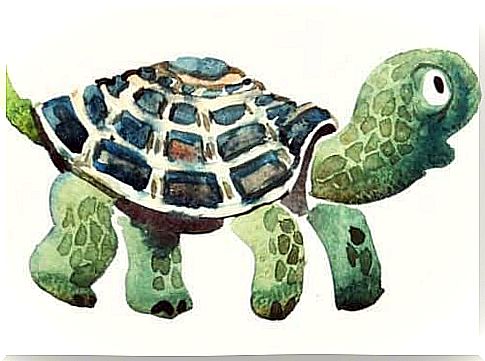Children’s Tantrums: The Turtle Technique

All children have tantrums. This is how they show their frustration when they don’t get what they want. It is nothing more than the proof that they do not know how to manage their emotions. The turtle technique is a good way to teach them how to deal with them.
The turtle technique can be practiced at home, but also in the classroom. In addition, it may be beneficial for children with ADHD (attention deficit disorder with or without hyperactivity).

The little turtle Manolita
When a child gets angry or has an impulsive reaction that ends in a tantrum, the first thing to do is remind them of the story of the little turtle Manolita. There she is :
Manolita is a little turtle who is always in trouble. When she can’t seem to do an exercise, she gets very angry and upset.
The same happens when the teacher catches her attention because she is chatting in class or when at recess a classmate pushes her and ends up kicking her. For all this, Manolita is usually punished or alone, because no friend wants to play with her.
All of this makes Manolita very sad, even though she cannot avoid the anger she feels in these situations. One day, coming home from school, she met a very old turtle who said to her:
– Manolita, don’t you realize that the solution to all your problems is in your shell? When you come across a situation that you can’t handle, go into your shell and count to 10.
The little turtle Manolita decided to put this into practice. When at recess a friend accidentally kicked her while playing soccer, she squeezed into her shell, counted to 10, and when she came out she wasn’t so angry anymore. ! She continued to play and have fun until recess ended.
This strategy helped her to see things in perspective. Everything has improved … Her classmates no longer leave her behind, the teacher no longer punishes her and she feels much better, more and more happy. So Manolita continued to use this strategy that this older turtle once gave her. It works !
The turtle technique: self-control
The turtle technique can be applied at any age. However, the sooner children learn to use it, the better. For this reason, during kindergarten it is useful that the little ones already know the story of the little turtle Manolita.
In addition, there are different ways of working with this technique. It’s not just about telling the story to the kids. They need to work on it to know how and when to use it. There are some very useful resources for this.
The word “turtle”
One technique that collects this article is the use of the word “turtle”. When a child is angry because he is being punished or because a classmate has done something to him , the teacher or a parent should say “turtle” out loud.
As this word is spoken, the child should squeeze his legs and rest his head on them, close his eyes and thus pretend to be inside a shell. For a few seconds, he should contract all his muscles, breathe deeply, and count to 10. After coming out of this position, the muscles will relax and the child will feel calmer.
A shelter shaped like a turtle shell
In kindergarten classes, there are usually toys. Therefore, another way to introduce them to controlling and managing their emotions may be to have a small house in the classroom that resembles the shell of a turtle.
When the teacher says the word turtle, the child who is angry or having a temper tantrum should enter this shelter. In this one, he must close his eyes and count to 10. He can also use the previous technique of contracting the muscles. When he comes out, the child will be calmer.

The technique in other stages
Why is it important for the turtle technique to be practiced from an early age? Because it will get children to automate a strategy that can help them regulate an emotion that, due to their level of maturity, may overtake them.
We will thus contribute to their adaptation to hostile environments, by laying precious bricks that will serve them in their adolescence. Emotional education, like education in many other types of disciplines, has very powerful effects when it takes place in childhood.
As we have seen, the turtle technique is one way to mature emotionally, but there are many more. Done right, all of them will add value to this emotional toolbox that we all carry inside of us.










